|

 Up
Up 
 The 1909
The 1909
Wright Glider 
(You are here.)



  Need
to Need
to
find your
bearings?
Try
these
navigation aids:
If
this is your first
visit, please stop by:
Something
to share?
Please:



|
|
Available in Française, Español, Português, Deutsch, Россию,
中文,
日本, and others.
[Ed. -- Once Wilbur Wright had demonstrated how to
fly in France and Italy, the Wrights quite literally could not build
planes fast enough to satisfy the Europeans who were anxious to get into
the air. Wilbur and Orville answered this impatience with a polite
suggestion that if the customer was so anxious to learn to fly, he might
tackle the subject the same way the Wrights had done -- learn to fly in a
glider first to develop some basic piloting skills. Then, when your brand
new Wright airplane arrives, you'll be that much safer in the air when you
take your first flight.
At least two pioneer aviators took this advice. Alec Ogilvie
and Ted Searight, who had submitted a joint order for a Wright Model A,
had Thomas Clarke and his brothers build them a glider. The design is
based on the 1902 Wright Glider, but there are some interesting
improvements -- a double surface wing, double canard, and skids. It is, in
fact, a hybrid between the Model A and the 1902 glider. More importantly,
it's designed to be flown in a much wider range of environments than the
1902 glider/
The 1902
Wright Glider was made to be flown over soft sand and, in our
experience,
the risk to the pilot goes up dramatically if it's flown over any other
sort of terrain. The 1909 Wright/Clarke Glider was designed to be launched
from and landed on rolling grass, prairies, fields, any smooth land
-- the sort of terrain available throughout most of Europe and America.
Consequently, it's a much more useful training tool for learning to fly a
Wright Flyer.
This article was published in two consecutive September 1909 issues
of Flight magazine.]



 liding is a side
of flight that is a little apt to be neglected in the present rush to
achieve the higher art; but it is a useful side nevertheless, and the
present is a particularly appropriate time to learn the mastery of the
motorless flyer, seeing there is for the moment some difficulty about
obtaining a proper supply of engines in this country. Other experimenters
have, it is true, shown that the stepping-stone used by the Brothers
Wright is not necessary in all cases; but, all the same, we are not at all
sure that gliding may not teach a lot even to the flying man, and in any
case it seems to us that Messrs. Alec Ogilvie and Searight have done very
much the right thing in having a glider built for them in addition to the
Wright flyer which they have on order. At the least it may be the means of
saving the flyer from some little unnecessary damage during the early
stages of learning to fly. liding is a side
of flight that is a little apt to be neglected in the present rush to
achieve the higher art; but it is a useful side nevertheless, and the
present is a particularly appropriate time to learn the mastery of the
motorless flyer, seeing there is for the moment some difficulty about
obtaining a proper supply of engines in this country. Other experimenters
have, it is true, shown that the stepping-stone used by the Brothers
Wright is not necessary in all cases; but, all the same, we are not at all
sure that gliding may not teach a lot even to the flying man, and in any
case it seems to us that Messrs. Alec Ogilvie and Searight have done very
much the right thing in having a glider built for them in addition to the
Wright flyer which they have on order. At the least it may be the means of
saving the flyer from some little unnecessary damage during the early
stages of learning to fly.
The glider which Messrs. Ogilvie and Searight have had built for them
is to all intents and purposes a copy of the machine used by the Wrights
in 1902, and the work has been admirably executed by Messrs. T. W. K..
Clarke and Co., of Kingston. It is of course a biplane, and has an
elevator in front with a vertical tail behind. The elevator, however, is
constructed according to the design shown in the latest Wright patent—with
which our readers are acquainted—having flexing planes instead of simple
pivoted planes. The tail at the rear consists of a single vertical plane,
in which respect it is in agreement with the Wright glider, but differs
from the Wright flyer, which has a double rudder. On the other hand the
main decks are double surfaced on the machine which Messrs. Clarke have
constructed, whereas the gliders used by the Wright Brothers were, we
believe, invariably only single surfaced. The workmanship which Messrs.
Clarke have put into the construction of the glider is admirable, and
thoroughly upholds British reputation for making a sound job. There are
some people who rather incline to the view that a machine which is going
to be knocked about need not have much time spent upon its construction in
the first instance, but for our own part we favor the other aspect of the
case for the two points which it has in its favor, the first being that
the better a machine is made the less liable is it to give trouble any
way, and the second being that when it does get smashed a well-made
article is always more easily and satisfactorily repaired than one which
is half a wreck to start with. Moreover, there is always the consideration
that a certain amount of risk attaches to flight, which it is gratuitous
to exaggerate by neglecting any reasonable proportions such as using a
decently built machine to fly on, and although, of course, a well-made
glider will probably cost more than one on which less care has been spent,
there is no reason why the old adage should not apply, "the best is
cheapest in the long run."
|
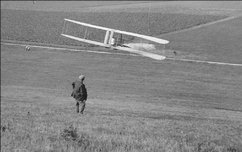
The Wright/Clarke Glider coasting down a grassy hill
in England. Note that the tail has been changed. In this photo, the glider
has a double rudder. In the drawings and other photos, the glider has only
a single rudder.
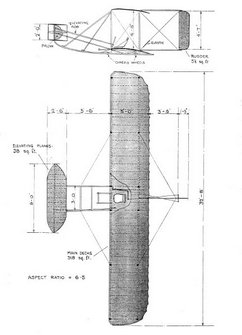
A two-view of the Wright/Clarke glider. Click on the
thumbnail to see the drawing sized to fit your screen. To download a
drawing that you can print out much larger, right-click
HERE.

Right front diagonal view of the complete
Wright/Clarke Glider. Light bow-skids are fitted under the extremities of
the lower wings at the wing tips.
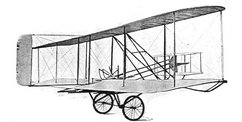
The glider mounted on a specially-designed two-wheel
hand cart, which allows one man to move it about easily.
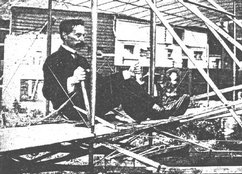
Thomas Clarke, builder, in the pilot's seat. Between
the runner are two wheels which support the machine on its launching rail. |
Timber and
Fabric
The material from which Messrs. Clarke have constructed the glider is
for the most part silver spruce, a timber which, we understand, they are
able to procure in 20 ft. lengths without a flaw. In one or two places
where bent woodwork is required—as, for instance, the extension of the
runners which carry the elevator, and the extremities of the main decks—American
elm is used. The decks are double-surfaced with a special fabric of
British make, which Messrs. T. W. K. Clarke supply ; it has a weight of 36
sq. ft. to the Ib., and the waterproofing is done by a celluloid
treatment. The seams in the complete covering are diagonal, and each half
of a deck, from an extremity to the center, is practically enclosed with a
kind of fabric bag, the edges of adjacent bags are laced together in the
center, while at intervals the fabric is tacked down to the supporting
ribs. In order to prevent the fabric being torn, a thin strip of wood is
placed between the fabric and the heads of the nails. |
Main
Decks
The skeleton framework on which the surfaces are stretched consists,
for each deck, of a pair of transverse spars having a section 1 inch deep
by 1-1/2 inches. At the extremities these spruce spars are joined together
by a piece of bent elm, a scarf joint being made between the two timbers.
At intervals of 1 ft., light ribs pass fore and aft between the spars and
overlap the rear spar to give a flexible trailing edge extending rearwards
about 15 ins. The ribs consist of two small strips of rectangular section
wood separated by distance pieces at intervals. Each rib as it is built up
is curved to a template so as to give a camber to the decks of 3 inches at
the maximum versine. The method of fastening the ribs to the front spar,
which by the way is rounded off to form a blunt cutting edge, is to secure
the last distance piece to the spar by screws so that it virtually belongs
to that member and, as it were, forms a supporting tongue for the top and
bottom members of the rib proper. The connection is then further
strengthened by putting a light strap of metal round the spar and tacking
the ends to the rib.
Considered as a unit, the framework of the two decks, taken together,
forms an example of the usual lattice girder work which has been commonly
adopted on biplanes. In accordance with the Wright system, the machine
built by Messrs. Clarke further belongs to the flexible type, that is to
say, non-rigid joints are employed as fastenings between the main spars
and the struts which separate them.
These joints are carried out somewhat after the manner devised by the
Wrights, but Mr. Clarke has substituted a steel plate for the wire eye
used in the Wright machine. The struts have a saw-cut taken down their
extremities for an inch or so, and into this is let the steel plate which
is pegged and bound in place. The projecting end of the steel is drilled
to receive a hook, which in this case consists of a steel U-bolt which
passes through the main spar and is secured on both sides by nuts. The
same steel plate also provides an anchorage for the wire ties.
|
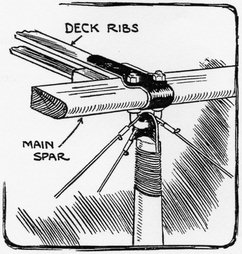
The flexible joints connecting the vertical struts to
the wings. A slight notch is made in the center of the U-bolt to keep the
strut centered.

Instead of pulleys where the warping wires leave the wings, short
length of Bowden wire sheaths are used.

A diagram of the wing assembly, showing the wing warping
wires and the manner in which the trailing edges are flexed. The leading
edges remain straight.
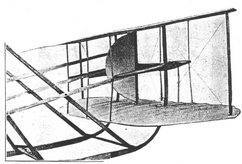
A detailed view of the elevator, showing its
attachment to the vertical portions of the runners. Also note the cutwater
or "blinker" situated between the two planes.
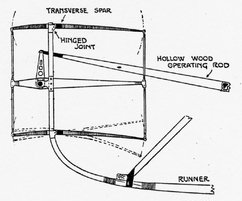
The Wright's patent flexing elevator is so arranged
that a movement of the operating rod, besides altering the angle of
attack, also varies the camber.
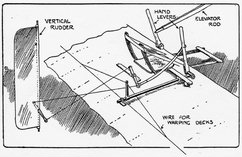
The central portion of the lower wing, showing the
cockpit and controls, including the manner in which the rudder is
connected.
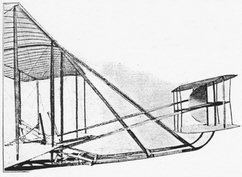
The front skids or runners, seen from the side. |
Elevator
and Tail
The elevator is, as has already been mentioned, constructed according
to the latest Wright patent, that is to say, the two planes are so mounted
that they flex or warp, instead of merely pivot when a change is made in
their angle of incidence by the operation of the elevating lever. In order
to accomplish this warping the two decks of the elevator are mounted in
rather a peculiar way, the framework of each being built up upon a single
transverse-spar situated about 9 inches from the leading edge; the full
cord of the elevator is 2 feet, 6 inches. There is thus a flexible leading
edge as well as a flexible trailing edge, the relative flexibilities being
more or less in proportion to the overhang of the main spar. The main spar
itself is pivoted to the uprights which support it in order to avoid
twisting strains when the decks are flexed; it is evident that although
the action of the elevator mainly consists of a warping action of the
decks, a certain amount of pivoting must necessarily occur simultaneously.
The operating mechanism for flexing the elevator decks consists of
three stiff ribs, which lie fore and aft, midway between the two decks of
the elevator. These members are fixed to a transverse tubular spar, which
is pivoted to a bracket projecting from the same upright as supports the
spars of the elevator decks; it is, however, situated some few inches
forward of their axes. From the extremities of each operating rib two
struts pass to the leading and trailing edges of the upper and lower decks
respectively, and it is by means of these struts that the elevating decks
are warped. The operation of manipulating the elevator is performed by
rocking the tubular transverse spar upon which the operating ribs are
mounted, and the fact that this spar is pivoted about a different center
to that on which the elevator decks are supported, causes a difference in
the relative amount of travel imparted to the leading and trailing edges.
The result of this is that instead of the elevator decks remaining flat
as they tilt or dip, their surfaces become cambered, and according as the
front edge is dipped or tilted so is the camber convex or concave to the
ground. The object of this system is to increase the efficiency of the
elevator by converting the decks, which are normally aeroplanes, into
cambered aerofoils directly they are required for use. As the elevator has
to work both ways, it is necessary to make provision for cambering in both
directions, hence the adoption of the device for mechanically warping the
decks in the manner described. For the purpose of rocking the tubular spar
to which reference has already been made, a simple lever and
connecting-rod are employed, the connecting-rod in this particular case
being built up so as to have a hollow rectangular section in order to give
greater stiffness.
Between the elevator decks is a semi-circular vertical plane forming a
prow. The tail, which is controlled y another lever, consists of a simple
plane mounted vertically between two out-rigger spars. These spars are
hinged to the rear transverse spars of the main decks so that they shall
not be readily broken if the tail strikes the ground. In order that this
hinging may be effective, that diagonal tie-wire which would ordinarily be
stretched as the result of any such deformation, is fitted with a length
of strong elastic. The elastic is sufficiently strong to keep the
outrigger in its proper position under normal conditions.
|
The
Chassis and Pilot's Seat
The machine as a whole is mounted upon two runners which commence a
short distance behind the main decks and extend forward with a gradual
curve which is ultimately increased in a sharp bend where they join on the
upright supports for the elevator. The runners are stayed to the front
spar of the upper main deck by a set of oblique struts. The lower deck is
supported a little above the rudders by a lattice work bracing.
The pilot is accommodated in an extremely light but fairly comfortable
chair—in which respect the machine differs from the original Wright
gliders, where the operator took the air lying prone on the lower deck.
|
The
Wright Control
On each side of the pilot is a vertical lever. That on the left moves
to and fro only, and works the elevator in the manner already described.
That on the right can move either to and fro or sideways, that is to say,
in reality it has a kind of universal motion. The two and fro movement
works the rudder, and the sideways motion warps the main decks. This
warping of the main decks is carried out by means of wires, which pass
through short lengths of Bowden tube, this method of guiding them being
considered by Mr. Clarke
to be far superior to the use of pulleys. It may here be mentioned,
while on the subject of wire bracing, that the main wire diagonals are not
fitted with any tightening device, being merely drawn hand-tight, and
fastened by simple brass bands, the ends of the wire being turned back
over the bands to prevent them from slipping.
The lateral control of a Wright glider, or flying machine, by a single
lever which warps the wings and moves the rudder, is the most interesting
and characteristic feature of the Wright system, but its action is apt to
be a little difficult to grasp unless each movement is taken in sequence.
The lever on the machine built by Messrs. Clarke is situated on the
pilot's right; it normally stands in a vertical position i when the
machine moves straight ahead on an even keel. The connections are such
that—
- If the lever is moved forward, the rudder puts the prow to the left.
- If the lever is moved to the right, the left hand extremities of the
main decks have their rear edges warped downwards so as to increase
the angle of incidence.
The next point to take into consideration is the primary result which
accompanies each of the above movements made independently.
- From steering to the left, the increased relative velocity of the
right wing tip will cant the machine so that the right wing rises.
- The first effect of increasing the angle of incidence of the
left-hand extremities of the main decks is to increase the resistance
of flight on that side of the machine, which consequently tends to
slow up, or in other words tends to put the prow of the machine to the
left.
If, on the other hand, the course is kept straight by using the rudder,
then the effect of increasing the angle on that side of the machine is to
raise the left extremity of the main decks and so cant the machine over
while it proceeds straight ahead. This maneuver may either be performed
for the purpose of restoring equilibrium from an accidentally canted
position or to establish a cant artificially for the purpose of banking
when taking a sharp turn.
It will be observed from the foregoing brief description that the to
and fro and sideways movements of the lever have results which are closely
related to one another and from which it is a simple matter to deduce that—
- If it is desired to restore equilibrium from an accidental cant
which has depressed the right hand extremity of the main decks, then
the lever must be drawn towards the pilot—i.e., to the left—in
order to increase the angle of incidence of the right hand extremities
of the main decks which it is desired to lift and at the same, time
the lever must be pushed forward so as to steer to the left in order
that the initial effect of warping described above shall not turn the
machine from its straight course.
The result of making, or rather trying to make, simultaneous movements
of the lever along axes at right angles to each other is to follow a
diagonal path; from this fact may be deduced the following very important
fact —
- Equilibrium and a straight course with the Wright flyer are
maintained by a diagonal movement of the lever, in which
- It is moved obliquely forward and towards the pilot, in order to
rectify an accidental canting of the right-hand extremities of the
main decks downwards, or
- The lever is moved obliquely backwards away from the pilot, in order
to check a cant which has depressed the left wing.
This oblique neutral line, represented in one of our diagrams, is the
normal path of travel for the pilot's right hand, while he keeps the
machine on a straight course. Any movement of the hand away from this line
must result in a curved course, because the rudder or the warping effect
preponderates.
The precise nature of the movement which the pilot would perform in
order to steer, say, to the left depends on the manner in which he wishes
is to carry out the operation, which in turn is governed by the sharpness
of the curve, his speed of flight and other considerations. In general,
however, it may be said that the pilot's hand for such a maneuver moves
through an oval path starting and finishing in the neutral vertical
position ; this oval path is the result of a perfectly performed sequence
of very short straight movements each of which has resulting in a
combination of warping and rudder action. Needless to say, such perfection
is not immediately within reach of the novice, the movements of whose hand
would be more than likely to show up the straight line components of the
curve.
It should perhaps be mentioned here that the reason why the rudder and
the warping of the planes has to take place simultaneously is primarily
due to the fact that the Wrights warp the main decks of the machine
instead of employing independent balancing planes. When the main decks of
a glider or flyer are warped it is not easy, even if it is possible, to
warp one extremity up and the other extremity down to an equal extent
considered from the point of view of effectiveness. To all intents and
purposes only that extremity which has its trailing edge warped downwards
need be taken into consideration, because while that undoubtedly does
exert a powerful lift, the corresponding warping of the other extremity
does not result in an equal amount of depressing action because the
resultant curvature of the decks at that end of the machine is such that
their angle of incidence is diminished but not effectively reversed. On
the one side of the machine, therefore, an active force is in operation,
whilst at the other extremity the conditions are rather of the passive
order. The resistance of that extremity which has an increased angle of
incidence given to it makes itself felt, and there is no corresponding
resistance at the opposite end of the flying machine to neutralize the
swerving effect which it induces ;on the contrary, the resistance there is
less than in the normal condition of straight line flight, so that the
swerving effect is outside. Hence the need for using the rudder.
|

In the diagram above, the small rectangle is the
right hand control lever viewed from the top. Move the lever right and left
to bank the glider and front to back to wag the tail. The arrows
designated as the "neutral line" show how the lever should be
moved to make coordinated turns.
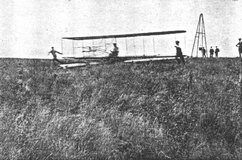
Launching the glider, using a derrick-catapult and
rail system in the same manner as launching a powered Wright airplane.
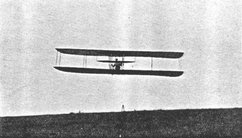
The Wright-Clarke Glider in flight.
Warping the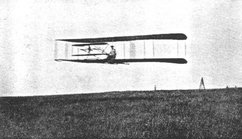 wings to begin a turn. wings to begin a turn.
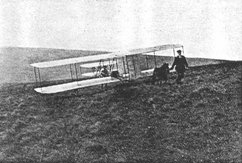
After the flight, a Shetland pony provides the
muscle to pull the glider back up the hill for another run. |
A
Word of Warning
Owing to a slight misunderstanding between ourselves and Messrs.
Ogilvie and Searight, the foregoing article has been published by us
without their prior knowledge. It should, moreover, be clearly understood
that this particular glider of theirs was built by them at the express
suggestion and with the direct permission of the Wright Brothers, pending
the delivery of the full-sized motor-driven Wright machine which Messrs.
A. Ogilvie and T. P. Searight have on order with them.
|
|
|
|
|